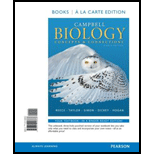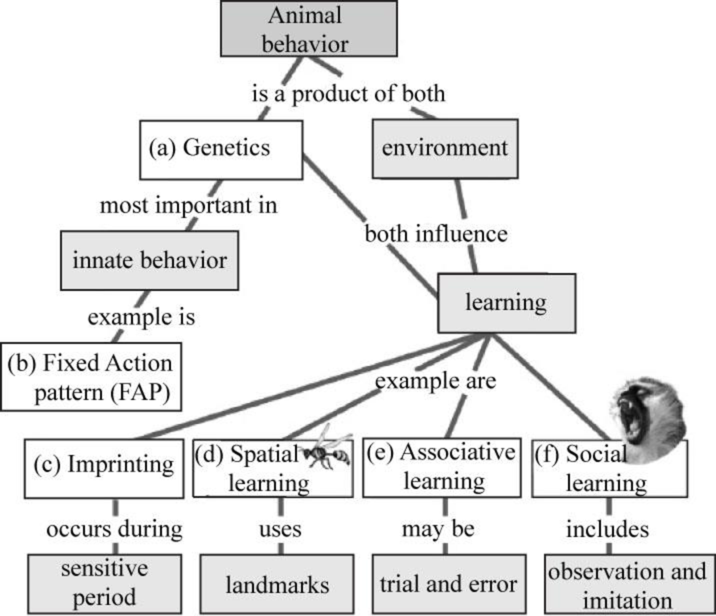
Concept explainers
To complete: The given map that reviews the genetic and environmental components of animal behavior and their relationship to learning.
Introduction:
The action of behavior is carried by the muscles that are in control of the nervous system in response to environmental stimulus. Thus, the behavior of animal is the response from internal and external environmental stimulus.
Explanation of Solution
Pictorial representation:
Fig.1 shows the completed map that reviews the genetic and environmental components of animal behavior and their relationship to learning.

Fig.1: Components animal behavior and their relationship to learning.
(a)
Correct answer: Genetics.
The animal behavior is a combined effect of genetics and environment and both influence the learning in animals. However, genetics is the main cause of innate behaviors. Hence, the correct answer is genetics.
(b)
Correct answer: Fixed Action pattern (FAP).
FAP is an unchangeable series of action caused by a particular stimulus. Hence, the correct answer is FAP.
(c)
Correct answer: Imprinting.
Imprinting is the sensitive phase that occurs after the hatching of the young ones. The first person that the young ones see will imprint with them like the hatched newborns see their mother; so, they follow her in a straight line whenever she goes for a walk. Hence, the correct answer is imprinting.
(d)
Correct answer: Spatial learning.
Spatial learning is the memories of landmarks created by animals with in their environment. The landmarks include trees, water, and mountains to find their way to home. It helps them to find a mate, food, nest, and possible dangers. The landmarks include trees, water, and mountains to find their way to home. Hence, the correct answer is spatial learning
(e)
Correct answer: Associative learning.
Associative learning is the association of result with a particular action by animals like while training a dog an individual feeds them with treats on performing well in training so they associate the food with the behavior while they learn. Hence, the correct answer is associative learning.
(f)
Correct answer: Social learning.
Social learning is the learning from other’s behavior by just watching or observing them. In an experiment, many octopus were put through the maze, while one is going in the maze, the others were tend to watch and the next time when they perform, they remember the path and finish it within less time. This concludes that the animals watch and learn from other’s behavior for a particular situation. Hence, the correct answer is social learning.
Want to see more full solutions like this?
Chapter 35 Solutions
Campbell Biology: Concepts & Connections, Books a la Carte Plus Mastering Biology with eText -- Access Card Package (8th Edition)
- Describe the levels of structural hierarchy for the human body, starting with the organismal level and ending with the chemical level. In addition, you should make sure you link each level to the previous level, emphasizing the structural relationships.arrow_forward9 S es Read the section "Investigating Life: In (Extremely) Cold Blood." Then, drag and drop the terms on the left to complete the concept map. Red blood cells Genes Icefishes -have mutated have colorless Oxygen have few lack encode Blood Cellular respiration consists of- contain carries is a Platelets White blood cells carries low amounts of Hemoglobin is necessary for Plasma Protein Reset.arrow_forwardPlating 50 microliters of a sample diluted by a factor of 10-6 produced 91 colonies. What was the originalcell density (CFU/ml) in the sample?arrow_forward
- Every tutor here has got this wrong, don't copy off them.arrow_forwardSuppose that the population from question #1 (data is in table below) is experiencing inbreeding depression (F=.25) (and no longer experiencing natural selection). Calculate the new expected genotype frequencies (f) in this population after one round of inbreeding. Please round to 3 decimal places. Genotype Adh Adh Number of Flies 595 Adh Adh 310 Adhs Adhs 95 Total 1000 fladh Adh- flAdn Adh fAdhs Adharrow_forwardWhich of the following best describes why it is difficult to develop antiviral drugs? Explain why. A. antiviral drugs are very difficult to develop andhave no side effects B. viruses are difficult to target because they usethe host cell’s enzymes and ribosomes tometabolize and replicate C. viruses are too small to be targeted by drugs D. viral infections usually clear up on their ownwith no problemsarrow_forward
- This question has 3 parts (A, B, & C), and is under the subject of Nutrition. Thank you!arrow_forwardThey got this question wrong the 2 previous times I uploaded it here, please make sure it's correvct this time.arrow_forwardThis question has multiple parts (A, B & C), and under the subject of Nutrition. Thank you!arrow_forward
- Calculate the CFU/ml of a urine sample if 138 E. coli colonies were counted on a Nutrient Agar Plate when0.5 mls were plated on the NA plate from a 10-9 dilution tube. You must highlight and express your answerin scientific notatioarrow_forwardDon't copy off the other answer if there is anyarrow_forwardAnswerarrow_forward
 Biology (MindTap Course List)BiologyISBN:9781337392938Author:Eldra Solomon, Charles Martin, Diana W. Martin, Linda R. BergPublisher:Cengage Learning
Biology (MindTap Course List)BiologyISBN:9781337392938Author:Eldra Solomon, Charles Martin, Diana W. Martin, Linda R. BergPublisher:Cengage Learning Biology: The Dynamic Science (MindTap Course List)BiologyISBN:9781305389892Author:Peter J. Russell, Paul E. Hertz, Beverly McMillanPublisher:Cengage Learning
Biology: The Dynamic Science (MindTap Course List)BiologyISBN:9781305389892Author:Peter J. Russell, Paul E. Hertz, Beverly McMillanPublisher:Cengage Learning Comprehensive Medical Assisting: Administrative a...NursingISBN:9781305964792Author:Wilburta Q. Lindh, Carol D. Tamparo, Barbara M. Dahl, Julie Morris, Cindy CorreaPublisher:Cengage Learning
Comprehensive Medical Assisting: Administrative a...NursingISBN:9781305964792Author:Wilburta Q. Lindh, Carol D. Tamparo, Barbara M. Dahl, Julie Morris, Cindy CorreaPublisher:Cengage Learning Human Heredity: Principles and Issues (MindTap Co...BiologyISBN:9781305251052Author:Michael CummingsPublisher:Cengage Learning
Human Heredity: Principles and Issues (MindTap Co...BiologyISBN:9781305251052Author:Michael CummingsPublisher:Cengage Learning Human Physiology: From Cells to Systems (MindTap ...BiologyISBN:9781285866932Author:Lauralee SherwoodPublisher:Cengage Learning
Human Physiology: From Cells to Systems (MindTap ...BiologyISBN:9781285866932Author:Lauralee SherwoodPublisher:Cengage Learning





